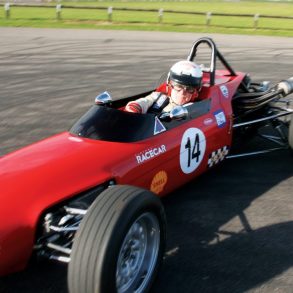Lotus 25
Car: Lotus-Climax 25 / Engine: 90 Deg V8 Coventry-Climax / Maker: Lotus / Bore X Stroke: 63 mm X 60 mm / Year: 1962 / Capacity: 1,498 cc / Class: Formula 1 / Power: 195 bhp at 8,200 rpm / Wheelbase: 2,286 mm Track: 1346 front, 1372 mm in rear / Weight: 452 kg / Tires: Dunlop 500-15R5 front, 650-15R5 rear tires
In 1961 the engine capacity for Formula 1 was reduced to 1.5 liters. Engines also need to run on 101.5 octane fuel instead of the 130 octane Avgas. The first year of the new regulations found all of the British teams down on power compared to Ferrari with the expected results. For 1962 Lotus would answer with the Lotus 25. Mid-engined cars were now standard and the Lotus 25 was not the first racing car with a monocoque chassis but its artistic simplicity and immense success in the hands of Jimmy Clark revolutionized Grand Prix racing car design. Monocoque construction had been used in aeronautical engineering for over 50 years. In 1915 Harry Blood campaigned a metal-fuselaged Carnelian at Indianapolis. Gabriel Voisin used a monocoque chassis for his car that he raced in the 1923 French GP and in 1955 BRM incorporated a semi-monocoque chassis in their Grand Prix cars.
Colin Chapman had experimented with a backbone chassis for the Lotus Elan sports car. He decided to apply the same techniques to a single-seater racing car. By using box-sections he created a tub just wide enough for a driver and within the box-section would go rubber bags to hold the fuel. While this was going on there was also a Type 24 being developed using a spaceframe just in case. As part of the design the drive would now sit in an almost reclining position that took some use to, and it took a brave man indeed to drive one of these cars at full speed.
The main benefits of this design were increased torsional rigidity for lees weight and with a smaller frontal area. The resulting stiffness allowed Lotus to use more supple suspension which offered great advantages in slower, tighter turns.
Colin Chapman was known as an instinctive seat of the pants designer. In fact when the first prototype was being built he took the opportunity of sitting in the car. To his surprise he found that he could fit quite comfortably and announced forthright that:
“This cockpit’s too wide … take another inch and a half out out of it!” Dick Scammell, one of the mechanics that built the first car would later remark that: “None of us really knew what we were doing, but it all took shape very nicely and it certainly looked right.”
Power was again provided by Coventry-Climax, the British forklift, fire pump, racing, and other specialty engine manufacturer. At £3000 per motor they hoped that Ferrari’s engine advantage would be bridged. The car was fast straight out of the box and with Clark driving, when it finished it usually won. In 1963, Engineer Len Terry was coaxed in to returning to the team that had fired him in 1959. One of his duties was to improve the car’s reliability. His work bore fruit when Scotsman Jim Clark after finishing 8th in Monaco won the next four races in a row. Clark would go on to win a then record seven out of ten races and his first World Championship. Graham Hill and Richie Ginther finished 2nd and 3rd respectively.



















